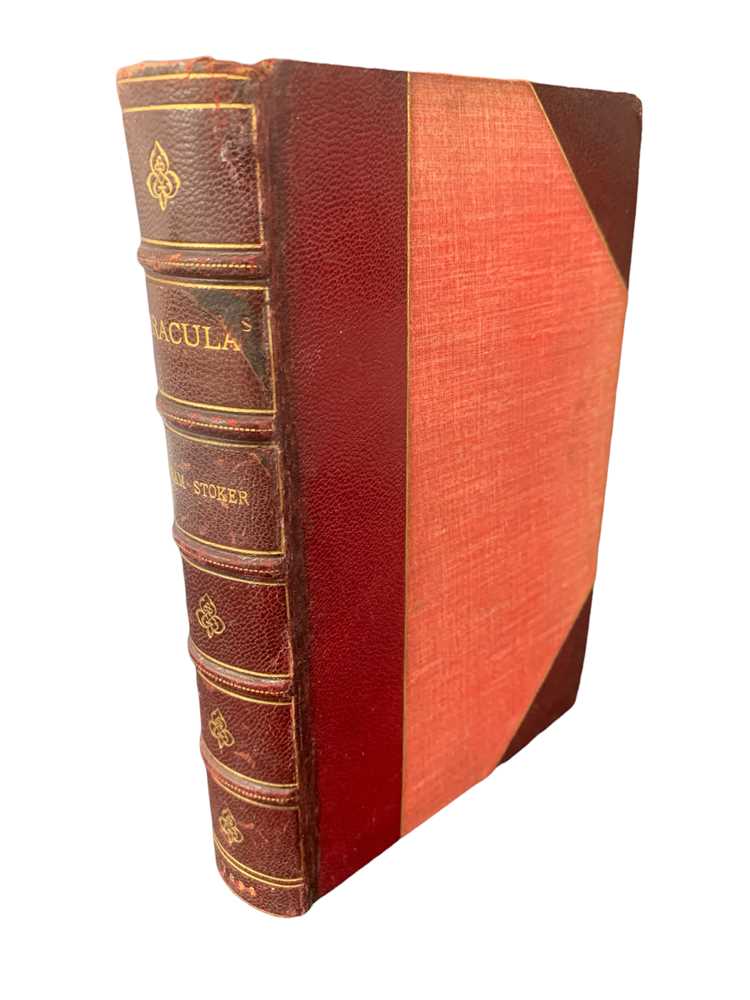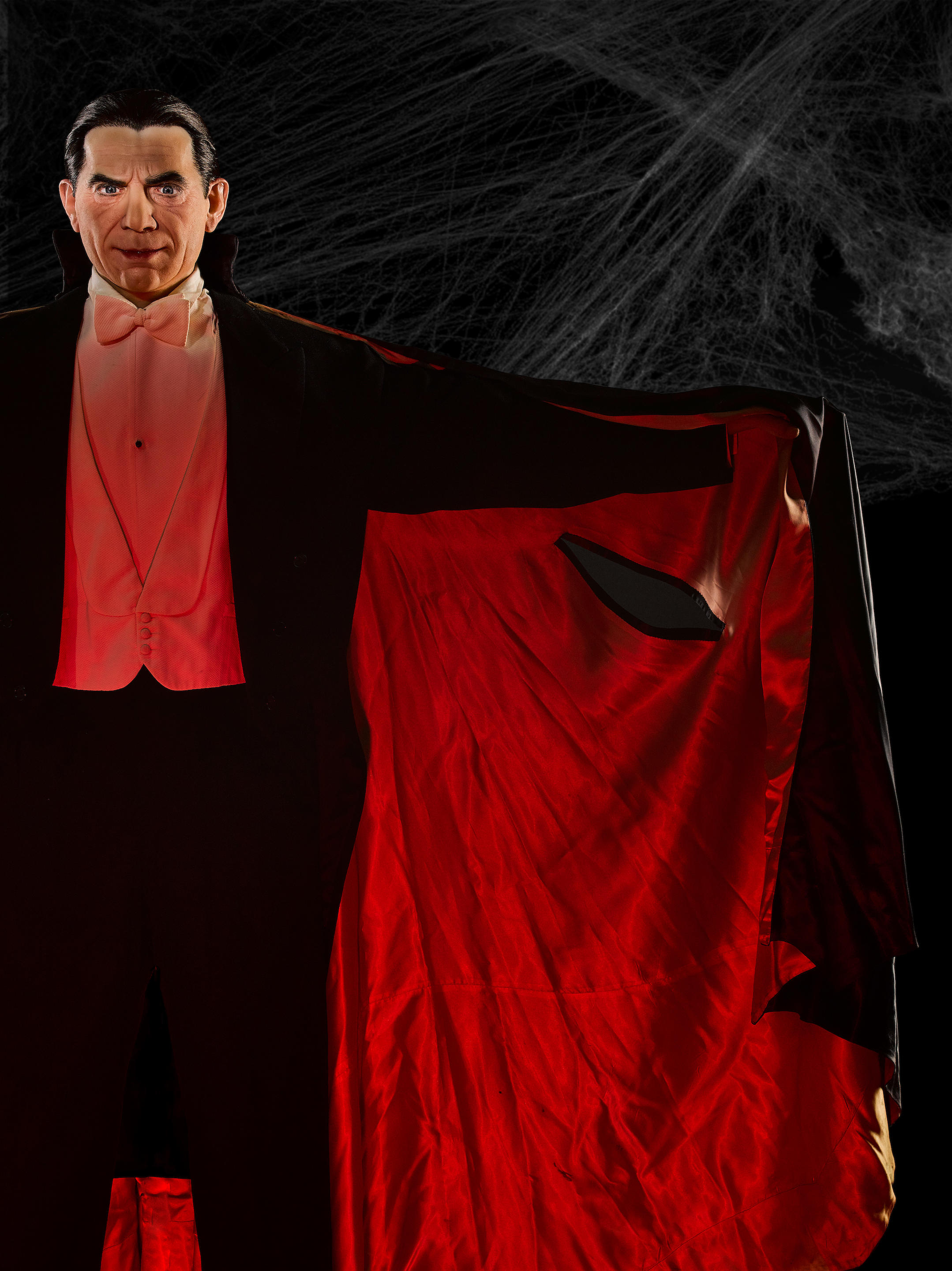Dracula, first issue Bram Stoker, 1897 STOKER, Bram (1847-1912). Dracula . London: Archibald Constable, 1897. First edition, first issue, with correspondence from Bram Stoker and from the book's dedicatee "Hommy-Beg," aka Hall Caine. The first issue is without the advertisement for Stoker's The Shoulder of Shasta on page [392]; the present is the variant with 8-page publisher's catalogue at end and the main body of text printed on uncoated wove paper. Bram Stoker first met the wildly popular novelist Hall Caine through their mutual friend Henry Irving. When Stoker proposed that he dedicate the book to his "dear friend Hommy-Beg," he wrote to Caine that "if the book is ever worth remembering it will be well understood what is meant" (23 February 1897). The letters from both authors included in the lot relate to their publishing activity. Stoker's letter confirms and expands a print run, likely a program or souvenir relating to a theatrical production. According to Bram Stoker's son Noel, the genesis of Dracula was a terrifying dream about a vampire king rising from his tomb, brought on by eating too much lobster. 3,000 copies of Dracula were sent to bookstores on 26 May 1897, and although reviews were mixed, Stoker's mother Charlotte wrote to him: "My dear, it is splendid, a thousand miles beyond anything you have written before, and I feel certain will place you very high in the writers of the day—the story and style being deeply sensational, exciting and interesting ... No book since Mrs. Shelley's Frankenstein or indeed any other at all has come near yours in originality, or terror." This maternal praise was echoed by a devoted Victorian readership but not by all contemporary critics, some of whom objected to the novel's imaginative structure. Arthur Conan Doyle, however, wrote that Dracula was "the very best story of diablerie which I have read for many years. It is really wonderful how with so much exciting interest over so long a book there is never an anticlimax." Stoker died 20 April 1912, not living long enough to see Dracula's immense cultural impact, and its many permutations in print and on the screen. Today, just over a hundred years since it was first published, Stoker's Dracula continues to assert a profound hold on the popular imagination. As a character, Count Dracula remains an archetype of exceptionally enduring power. His nocturnal savageries are both deeply repellent and yet strangely compelling. Bleiler, The Checklist of Science-Fiction and Supernatural Fiction (1978), p.187; Dalby 10(a); Wolff 6581. Octavo (193 x 125mm). Half-title. 8-page publisher's advertisements at end printed on laid paper (last gathering with some edge tears, apparently hastily opened). Original yellow cloth lettered in red (spine darkened, light soiling, a few small abrasions on upper cover retouched, lower hinge cracked); vintage carbon print portrait of the novelist Hall Caine affixed to lower inside cover. [ With :] Autograph letter signed ("Bram Stoker") on Lyceum Theater stationery, 30 October 1889, to J[ohn] Hamer. One page (tear through date). [ And :] CAINE, Hall (1853-1931). Autograph letter signed ("Hall Caine"), Bexley Heath, 3 October 1886, to Mssrs Chatto & Windus. One page. Housed together in morocco-backed clamshell box.
Dracula, first issue Bram Stoker, 1897 STOKER, Bram (1847-1912). Dracula . London: Archibald Constable, 1897. First edition, first issue, with correspondence from Bram Stoker and from the book's dedicatee "Hommy-Beg," aka Hall Caine. The first issue is without the advertisement for Stoker's The Shoulder of Shasta on page [392]; the present is the variant with 8-page publisher's catalogue at end and the main body of text printed on uncoated wove paper. Bram Stoker first met the wildly popular novelist Hall Caine through their mutual friend Henry Irving. When Stoker proposed that he dedicate the book to his "dear friend Hommy-Beg," he wrote to Caine that "if the book is ever worth remembering it will be well understood what is meant" (23 February 1897). The letters from both authors included in the lot relate to their publishing activity. Stoker's letter confirms and expands a print run, likely a program or souvenir relating to a theatrical production. According to Bram Stoker's son Noel, the genesis of Dracula was a terrifying dream about a vampire king rising from his tomb, brought on by eating too much lobster. 3,000 copies of Dracula were sent to bookstores on 26 May 1897, and although reviews were mixed, Stoker's mother Charlotte wrote to him: "My dear, it is splendid, a thousand miles beyond anything you have written before, and I feel certain will place you very high in the writers of the day—the story and style being deeply sensational, exciting and interesting ... No book since Mrs. Shelley's Frankenstein or indeed any other at all has come near yours in originality, or terror." This maternal praise was echoed by a devoted Victorian readership but not by all contemporary critics, some of whom objected to the novel's imaginative structure. Arthur Conan Doyle, however, wrote that Dracula was "the very best story of diablerie which I have read for many years. It is really wonderful how with so much exciting interest over so long a book there is never an anticlimax." Stoker died 20 April 1912, not living long enough to see Dracula's immense cultural impact, and its many permutations in print and on the screen. Today, just over a hundred years since it was first published, Stoker's Dracula continues to assert a profound hold on the popular imagination. As a character, Count Dracula remains an archetype of exceptionally enduring power. His nocturnal savageries are both deeply repellent and yet strangely compelling. Bleiler, The Checklist of Science-Fiction and Supernatural Fiction (1978), p.187; Dalby 10(a); Wolff 6581. Octavo (193 x 125mm). Half-title. 8-page publisher's advertisements at end printed on laid paper (last gathering with some edge tears, apparently hastily opened). Original yellow cloth lettered in red (spine darkened, light soiling, a few small abrasions on upper cover retouched, lower hinge cracked); vintage carbon print portrait of the novelist Hall Caine affixed to lower inside cover. [ With :] Autograph letter signed ("Bram Stoker") on Lyceum Theater stationery, 30 October 1889, to J[ohn] Hamer. One page (tear through date). [ And :] CAINE, Hall (1853-1931). Autograph letter signed ("Hall Caine"), Bexley Heath, 3 October 1886, to Mssrs Chatto & Windus. One page. Housed together in morocco-backed clamshell box.
.jpg)














Try LotSearch and its premium features for 7 days - without any costs!
Be notified automatically about new items in upcoming auctions.
Create an alert